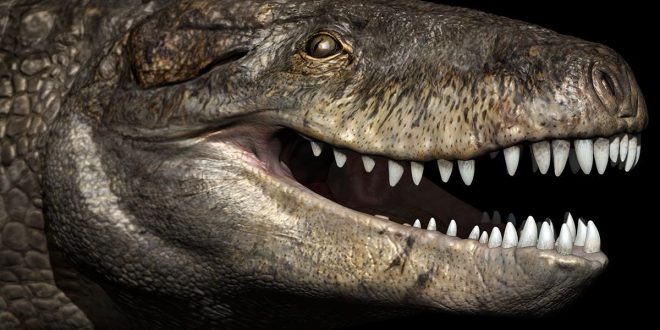New study on fossils from Madagascar by Italian and French paleontologists has uncovered a previously unknown Jurassic beast. The research is published in PeerJ.
With deep and massive jaw bones and gigantic, serrated teeth – much like those of a Tyrannosaurus rex – Razanandrongobe sakalavae was undoubtedly a fearsome predator 165 million years ago.
Nicknamed “Razana,” this large carnivore was first identified in a 2006 paper authored by paleontologists Cristiano Dal Sasso and Simone Maganuco of the Museo Civico di Storia Naturale di Milano (Natural History Museum of Milan), along with researcher Giovanni Pasini. Based on the fossils, which consisted of large serrated teeth and some jawbone fragments, the researchers concluded that this was a major predator in this Madagascan ecosystem some 166 million years ago.
“Razana was probably an opportunistic animal, just like hyenas and lions,” Dal Sasso told me over email. The meat-eater could probably swim, though it was built to walk on dry land, he said, noting that it was “not a very fast runner, but an ambush predator, and a scavenger.”
However, Dal Sasso and his colleagues were unclear about the animal’s place in the tree of life. Its bone-crushing teeth resemble those of colossal theropod dinosaurs like T. rex, but its squat frame suggests it could be a crocodylomorph, the ancient lineage from which all modern crocodilians descended.
The trio of authors, along with paleontologist Guillaume Fleury of the Muséum d’Histoire Naturelle de Toulouse in France, have now resolved this phylogenetic enigma by presenting new cranial remains of the animal in their paper. The verdict: Razanandrongobe sakalavae is a crocodylomorph. And not just any crocodylomorph—this species “is clearly a Jurassic notosuchian,” the team said, making it “by far the oldest representative of the group, predating the other forms by about 42 million years.”
Notosuchians are one of the most fascinating families in the fossil record. These croc relatives proliferated all over the bygone Gondwanan landmass, scattering their fossilized bones across South America, Africa, Europe, and Asia. They were a diverse bunch, producing herbivorous, omnivorous, and carnivorous offshoots, and evolving into a menagerie of assorted shapes and sizes dated to the Cretaceous period. Razanandrongobe sakalavae is the first Jurassic notosuchian ever identified, which “begins to fill the ghost lineage of notosuchians” in that period, the authors said.
At the time that Razana lived, its native Madagascar was starting to split from the Gondwanan supercontinent, a separation that would eventually produce the unique ecosystem we associate with the island today. Dal Sasso told me the predator likely feasted on sauropod stragglers (long-necked herbivores), small mammals, and pterosaurs, but it will require more fossil evidence to make any broader conclusions about this basal notosuchian’s behavior and anatomy.
“It would be nice to find at least some bones of the postcranial skeleton, in order to confirm that Razana had a body construction similar to the sebecosuchian notosuchia,” a group that includes the hulking predator Baurusuchus salgadoensis, Dal Sasso said.
Agencies/Canadajournal
 Canada Journal – News of the World Articles and videos to bring you the biggest Canadian news stories from across the country every day
Canada Journal – News of the World Articles and videos to bring you the biggest Canadian news stories from across the country every day



